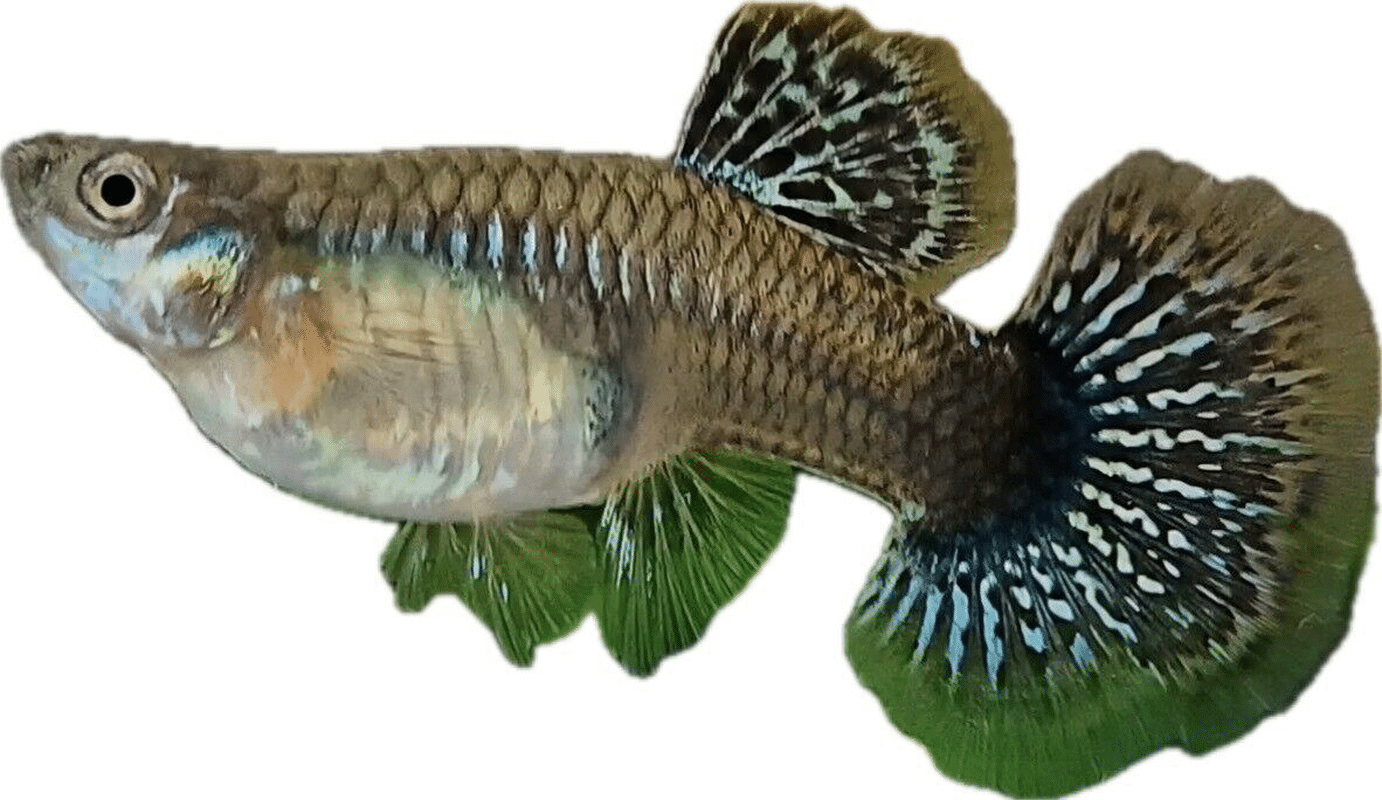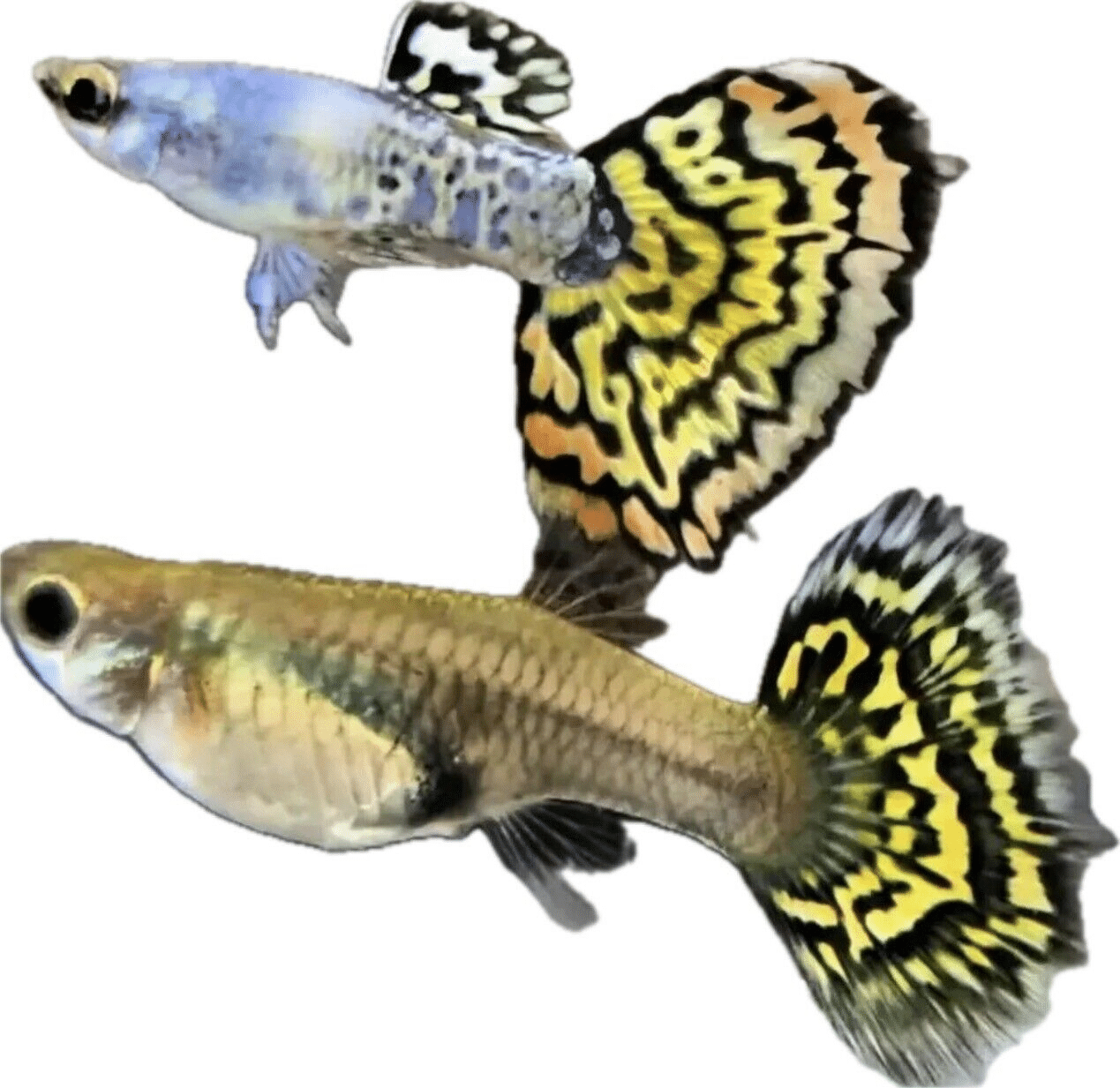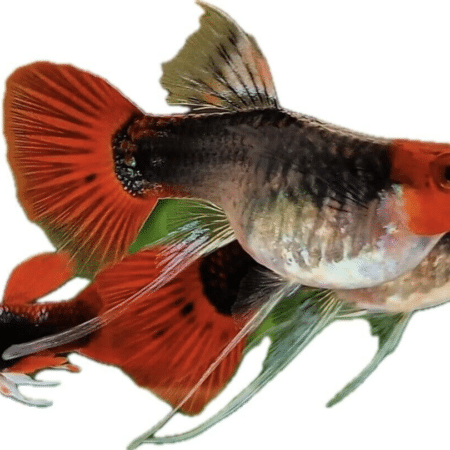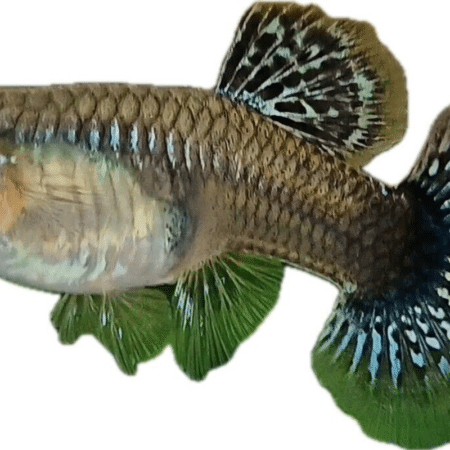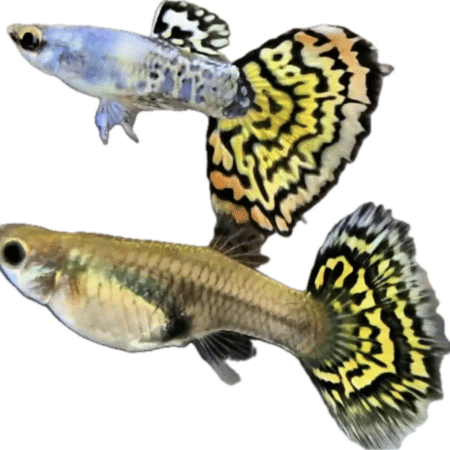PREMIER GUPPY ASSORTED FEMALE Randomly Selected Lovely Fish, Stunning Freshwater Beauties That Enhance Your Aquarium, Learn How to Care for These Adorable Tropical Fish
£2.49 Original price was: £2.49.£1.94Current price is: £1.94.
Welcome these beautiful Premier Guppy Assorted Female fish into your aquarium. With their vibrant colors and unique patterns, they are perfect for creating a stunning aquatic display. Ideal for beginners, they thrive in community tanks and come with a guppy care guide to ensure their well-being.
434 in stock
Species Introduction
The Premier Guppy, scientifically known as Poecilia reticulata, is a captivating freshwater fish that hails from the vibrant ecosystems of South America, particularly in regions such as Guyana, Venezuela, and Brazil. These beautiful inhabitants are renowned for their stunning array of colors and patterns, making them a favorite among aquarium enthusiasts and a perfect addition to community tanks. Guppies thrive in warm, shallow waters, often found in streams, ponds, and marshes where they can easily find shelter among aquatic plants. Their natural habitat is characterized by a rich biodiversity, which contributes to their adaptability and resilience in various water conditions. As a member of the Poeciliidae family, guppies are livebearers, meaning they give birth to free-swimming young, which adds an exciting dynamic to their care and breeding. Understanding their origins and natural behaviors is essential for creating an optimal environment that mimics their native habitat, ensuring their health and well-being in your aquarium.
Essential Care Guide for Your PREMIER GUPPY ASSORTED FEMALE Randomly Selected Lovely Fish
| Optimal Living Conditions | |
|---|---|
| Water Temperature | 24-27°C (75-81°F) |
| pH Level | 6.5-7.5 |
| Water Hardness | 4-12 dKH |
| Minimum Tank Size | 80L (20 gal) |
| Salinity | Freshwater |
| Care Level | Beginner Friendly |
✓ Care Level: Easy
To successfully care for your Premier Guppy, it is recommended to provide a minimum tank size of 10 gallons, which allows for adequate swimming space and promotes a healthy environment. The ideal water parameters include a temperature range of 24-28°C (75-82°F), a pH level between 6.8 and 7.8, and a hardness of 10-30 dGH. Regular water changes of 10-20% weekly will help maintain water quality and prevent the buildup of harmful toxins. Guppies are generally graceful fish, making them suitable for beginners, but they do require stable conditions to thrive. Providing a well-planted tank with plenty of hiding spots will not only enhance their well-being but also mimic their natural habitat, allowing them to exhibit their natural behaviors.
Natural Behavior & Temperament
Premier Guppies are known for their lively and social nature, often swimming in schools and displaying playful behaviors. They are peaceful companions, making them ideal for community tanks where they can coexist with other non-aggressive species. Their natural behavior includes frequent darting and exploring their surroundings, which is why a spacious and well-decorated tank is essential. Guppies also exhibit interesting social interactions, especially during mating displays where males showcase their vibrant colors to attract females. Observing these interactions can be a delightful experience for aquarists, as it highlights the dynamic social structures within their schools. However, it is important to monitor their behavior closely, as stress can lead to health issues. Providing a calm and stable environment will encourage your guppies to thrive and exhibit their natural behaviors.
Tank Setup Guide
Creating an ideal tank setup for your Premier Guppy involves several key considerations. First and foremost, choose a tank that is at least 10 gallons to provide ample swimming space. Use a fine substrate such as sand or small gravel to mimic their natural habitat, and incorporate live plants like Java Fern or Anubias, which not only enhance the aesthetic appeal but also provide hiding spots and breeding areas. Decorations such as driftwood and rocks can create territories and enrich the environment. Ensure that the tank has a reliable filtration system to maintain water quality, as guppies are sensitive to poor water conditions. Additionally, consider using a heater to maintain stable temperatures, as fluctuations can stress these delicate fish. Lighting should be moderate; too much light can promote algae growth, while too little can affect plant health. Regular maintenance, including cleaning the substrate and performing water changes, will ensure a thriving environment for your guppies.
Water Quality Management
Maintaining optimal water quality is crucial for the health of your Premier Guppy. The ideal pH level should range between 6.8 and 7.8, with a temperature maintained between 24-28°C (75-82°F). Regular testing of water parameters using reliable test kits is essential to ensure that ammonia and nitrite levels remain at zero, while nitrate levels should be kept below 20 ppm. A well-cycled tank will help establish beneficial bacteria that break down waste products, contributing to a healthy environment. Additionally, maintaining a hardness level of 10-30 dGH is important for guppy health, as it affects their overall well-being. Regular water changes of 10-20% weekly will help dilute toxins and replenish essential minerals, ensuring that your guppies thrive in a clean and stable environment. Always dechlorinate tap water before adding it to the tank, as chlorine can be harmful to your fish.
Feeding & Nutrition
Feeding your Premier Guppy a balanced diet is vital for their health and longevity. These fish are omnivorous and thrive on a varied diet that includes high-quality flake food, frozen or live foods such as brine shrimp, daphnia, and bloodworms. A feeding schedule of 2-3 small meals per day is recommended, ensuring that they consume all food within a few minutes to prevent overfeeding and maintain water quality. It is essential to provide a mix of protein-rich foods and plant-based options to support their growth and coloration. Additionally, consider incorporating algae wafers or spirulina flakes to enhance their diet. Monitoring their feeding habits can also help identify any health issues; if your guppy is not eating, it may indicate stress or illness. By providing a nutritious and varied diet, you can ensure that your guppies remain vibrant and healthy.
Compatibility Guide
✓ Community Tank Friendly
Premier Guppies are known for their peaceful temperament, making them excellent candidates for community tanks. They can coexist harmoniously with other small, non-aggressive fish such as neon tetras, rasboras, and small corydoras catfish. However, it is crucial to avoid housing them with larger or aggressive species that may view them as prey. Guppies are also social creatures, so it is advisable to keep them in groups of at least three to promote their natural behaviors and reduce stress. When introducing new tank mates, ensure that all fish are of similar size and temperament to maintain a balanced community. Regular observation of interactions among tank mates will help you identify any potential issues and ensure a peaceful environment for your aquatic companions.
Health & Wellness
Maintaining the health and wellness of your Premier Guppy involves regular monitoring and proactive care. Common health issues that guppies may face include fin rot, ich, and swim bladder disease. Signs of illness can include lethargy, loss of appetite, and visible lesions or discoloration. To prevent these issues, ensure that water quality remains optimal and avoid overstocking the tank. Quarantining new fish before introducing them to the main tank can also help prevent the spread of diseases. Regularly inspect your guppies for any signs of distress or illness, and if any issues arise, consider consulting with an aquatic veterinarian for appropriate treatment options. Providing a stress-free environment, proper nutrition, and regular water changes will significantly contribute to the overall health and longevity of your guppies.
Breeding Information
Breeding Premier Guppies can be a rewarding experience for aquarists. Guppies are livebearers, meaning they give birth to live young rather than laying eggs. To breed guppies successfully, it is essential to maintain a ratio of one male to two or three females to reduce stress on the females during mating. The breeding process typically occurs when the male displays his vibrant colors and performs courtship dances to attract the female. After successful mating, the female will carry the fertilized eggs for about 4-6 weeks before giving birth to fry. It is crucial to provide plenty of hiding spots in the tank for the fry to escape predation from adult fish. Once the fry are born, they should be fed finely crushed flakes or specialized fry food to ensure proper growth. Monitoring the fry closely and providing optimal conditions will help ensure their survival and healthy development.
Acclimation Process
Acclimating your Premier Guppy to a new tank is a critical step to ensure their health and reduce stress. When introducing new fish, it is essential to perform a gradual acclimation process. Start by floating the sealed bag containing the guppy in the tank for about 15-20 minutes to equalize the temperature. Afterward, gradually mix small amounts of tank water into the bag every 5-10 minutes for about an hour. This helps the guppy adjust to the new water parameters. Once acclimated, gently release the guppy into the tank using a net to avoid introducing any excess water from the bag. It is important to monitor the guppy closely for the first few days in the new environment, watching for signs of stress or illness. Providing a calm and stable environment will help your guppy transition smoothly into their new home.
Long-term Care
The long-term care of your Premier Guppy involves understanding their lifecycle and growth expectations. Guppies typically live for 2-3 years, but with proper care, some can live even longer. It is essential to provide a stable environment with consistent water parameters and a balanced diet to ensure their longevity. Regular monitoring of their health and behavior will help you identify any potential issues early on. As guppies age, they may become less active, and their colors may fade, which is a natural part of their lifecycle. Maintaining a clean tank and providing adequate space will contribute to their overall well-being. Additionally, consider rotating tank mates periodically to stimulate their environment and promote healthy behaviors. By providing attentive care and monitoring their needs, you can enjoy the beauty and companionship of your Premier Guppies for years to come.
Natural Habitat Recreation
Recreating the natural habitat of your Premier Guppy is essential for their well-being and encourages natural behaviors. In the wild, guppies inhabit shallow waters with abundant vegetation, so incorporating live plants such as Java Moss, Hornwort, and floating plants will create a similar environment in your aquarium. Providing hiding spots using driftwood, rocks, and caves will not only enhance the aesthetic appeal but also offer shelter for your fish. Additionally, consider using a gentle filtration system to mimic the natural flow of water found in their native habitats. This setup will promote a sense of security and allow your guppies to exhibit their natural swimming patterns. Regular maintenance, including trimming plants and cleaning decorations, will help maintain a healthy and visually appealing environment for your guppies.
Seasonal Care Adjustments
Seasonal changes can impact the care requirements of your Premier Guppy, necessitating adjustments to their environment. In warmer months, ensure that the tank temperature does not exceed 28°C (82°F) to prevent heat stress. Consider using a fan or air conditioning to regulate the temperature if necessary. During colder months, maintaining a stable temperature is crucial, so using a reliable heater is recommended. Additionally, monitor the lighting duration as seasonal changes can affect plant growth and fish behavior. Providing a consistent light cycle of 10-12 hours per day will support both plant health and the natural rhythms of your guppies. Regularly checking water parameters during seasonal transitions will help you identify any fluctuations and make necessary adjustments to maintain a healthy environment.
Expert Tips
To ensure the best care for your Premier Guppy, consider these expert tips. First, always quarantine new fish before introducing them to your main tank to prevent the spread of disease. Regularly monitor water parameters and perform routine maintenance to keep the tank environment stable. Additionally, consider keeping a journal to track your guppies’ growth, breeding, and health patterns, which can help you identify any changes or issues that may arise. Providing a varied diet will enhance their coloration and vitality, so be sure to rotate foods regularly. Lastly, engage with online communities or local clubs to share experiences and gather insights from other guppy enthusiasts. By implementing these expert tips, you can create a thriving environment for your Premier Guppies, ensuring they remain healthy and vibrant.
Troubleshooting
Despite your best efforts, you may encounter challenges while caring for your Premier Guppy. Common problems include stress, illness, and compatibility issues. If you notice signs of stress such as hiding, lethargy, or aggressive behavior, assess the tank environment for potential stressors such as poor water quality, overcrowding, or aggressive tank mates. If illness occurs, promptly isolate affected fish and consider treatment options based on observed symptoms. Regular water testing and maintenance will help prevent many common issues. If you experience compatibility problems, reevaluate the tank mates and consider rehoming aggressive species. By being proactive and attentive to your guppies’ needs, you can effectively troubleshoot and resolve any challenges that arise in their care.
Scientific Background
The Premier Guppy, or Poecilia reticulata, is a fascinating species with a rich scientific background. Belonging to the family Poeciliidae, guppies are part of a larger group of livebearing fish that exhibit remarkable adaptability to various aquatic environments. Extensive research has been conducted on guppy behavior, genetics, and ecology, revealing insights into their reproductive strategies and social dynamics. Guppies are often used in scientific studies due to their rapid reproduction and visible traits, making them ideal for genetic research. Conservation efforts are also essential for preserving wild guppy populations, as habitat destruction and pollution pose significant threats to their natural ecosystems. Understanding the scientific background of your guppies not only enhances your appreciation for these beautiful creatures but also informs better care practices.
Advanced Care Techniques
For those looking to elevate their guppy care, consider implementing advanced techniques to optimize their environment and health. One effective method is to establish a breeding program, which involves selecting specific traits for breeding to enhance coloration and health in future generations. Additionally, utilizing live plants not only beautifies the tank but also helps maintain water quality by absorbing nitrates and providing natural filtration. Implementing a varied diet that includes high-quality pellets, live foods, and vegetables can significantly improve the health and vibrancy of your guppies. Regularly rotating foods and incorporating supplements can also enhance their immune systems. Furthermore, engaging in regular observation and record-keeping will help you identify trends in behavior and health, allowing for timely interventions when necessary. By adopting these advanced care techniques, you can ensure that your Premier Guppies thrive and flourish in your aquarium.
Water Quality Parameters
Optimal Range
24-27°C
6.5-7.5
0 ppm
Caution Zone
22-24°C or 27-29°C
6.0-6.5 or 7.5-8.0
0.25-0.5 ppm
Danger Zone
<22°C or >29°C
<6.0 or >8.0
>0.5 ppm
Monitoring Tip: Test water parameters weekly and perform regular water changes to maintain optimal conditions for your aquatic friends!
Frequently Asked Questions
Q: What tank size is required for female guppies?
For female guppies, a minimum tank size of 60 litres is recommended. This size provides ample swimming space and helps maintain stable water parameters. A larger tank allows for a more stable environment, which is essential for their health and wellbeing. Additionally, it is advisable to keep at least five guppies together to create a social group, which further necessitates a larger tank. Overcrowding can lead to stress and health issues, so proper stocking levels should be adhered to.
✓ Expert Tip
Consider adding live plants and decorations to enhance their environment, providing hiding spots and reducing stress.
Q: What water parameters do female guppies require?
Female guppies thrive in water temperatures between 24-28°C, with a pH level of 6.8 to 7.8. It is crucial to ensure that the water is soft to moderately hard, ideally between 5-20 dGH. Regular water changes of 10-15% weekly help maintain optimal water quality and reduce harmful toxins. Testing kits can be used to monitor these parameters, ensuring a healthy habitat. Stability is key; avoid sudden changes in temperature or pH, as guppies are sensitive to fluctuations.
✓ Expert Tip
Utilise a high-quality filter to maintain water clarity and quality, which is vital for the health of your fish.
Q: How often should I feed female guppies?
Female guppies should be fed 2-3 times a day, with only as much food as they can consume in 2-3 minutes. A varied diet is essential for their health; consider high-quality flakes, pellets, and occasional treats such as frozen or live food. Overfeeding can lead to water quality issues and health problems, so moderation is key. Always remove any uneaten food promptly to maintain water quality.
✓ Expert Tip
Incorporating high-protein food can enhance their colouration and overall health.
Q: What are the best tank mates for female guppies?
Female guppies are generally peaceful and can coexist with various community fish. Suitable tank mates include tetras, rasboras, and other small, non-aggressive species. Avoid larger or aggressive fish that may see guppies as food or stress them. It is also wise to avoid keeping them with fin-nippers like some cichlids or aggressive barbs. Always observe the behaviour of your fish after adding new tank mates to ensure compatibility.
✓ Expert Tip
Ensure a ratio of more females than males to prevent harassment and stress among your guppies.
Q: How do I properly acclimatise female guppies to my aquarium?
Acclimatising female guppies is crucial for their health. Start by floating the sealed bag in your aquarium for about 15-20 minutes to equalise the temperature. After this, gradually introduce small amounts of tank water into the bag over the next hour. This helps them adjust to differences in water chemistry. Once acclimatised, gently net the guppies and place them in the aquarium, avoiding adding bag water to your tank to prevent contamination.
✓ Expert Tip
Acclimatise during low light conditions to reduce stress levels in your new fish friends.
Q: What are the signs of healthy female guppies?
Healthy female guppies exhibit bright colours, clear eyes, and active swimming behaviour. They should be inquisitive and responsive to their environment. Signs of distress or illness include lethargy, faded colours, clamped fins, or abnormal swimming patterns. Regular observation is essential to catch any potential issues early. Maintaining a proper diet and water conditions will significantly enhance their wellbeing, leading to vibrant and active fish.
✓ Expert Tip
Keep a journal of your fish’s behaviour; it can help you notice changes that may indicate health issues.
Q: How do I successfully breed female guppies?
Breeding female guppies is relatively straightforward. Ensure a ratio of one male to at least two females to reduce stress on the females. Provide plenty of hiding spots with plants or decorations, as females prefer to give birth in secluded areas. Monitor water conditions closely, as stable parameters are crucial for fry survival. After giving birth, remove the fry to a separate tank to protect them from being eaten by adult fish.
✓ Expert Tip
Feed the fry a high-quality powdered food to ensure proper growth and development.
Q: What temperature should I maintain for female guppies?
The ideal temperature range for female guppies is between 24°C and 28°C. Maintaining a consistent temperature within this range is crucial for their health and breeding. Sudden temperature fluctuations can lead to stress and illness. Using a reliable aquarium heater and thermometer can help achieve and monitor the desired temperature. Always check the settings regularly to ensure optimal living conditions for your fish friends.
✓ Expert Tip
Consider placing the heater near the filter outlet to ensure even heat distribution throughout the tank.
Q: How long do female guppies typically live in captivity?
In captivity, female guppies can live for 2-3 years, provided they are given proper care. Factors such as water quality, diet, and tank conditions play a significant role in their lifespan. Regular maintenance, including water changes and monitoring of tank mates, can help extend their life. It’s essential to stay vigilant for signs of stress or illness, as early intervention can often lead to better outcomes.
✓ Expert Tip
Keep a consistent routine for feeding, cleaning, and tank maintenance to promote a healthy environment.
Q: What type of substrate is most suitable for female guppies?
For female guppies, a fine gravel or sand substrate is ideal. This type of substrate allows for easy plant growth and provides a comfortable environment for the fish. It is essential to avoid sharp or rough substrates that could injure their delicate fins. Additionally, a darker substrate can help enhance the colours of the guppies, making them more vibrant. Regular cleaning of the substrate is necessary to avoid waste accumulation and maintain water quality.
✓ Expert Tip
Consider incorporating live plants into the substrate for a more natural and stimulating environment.
Q: What behavioural patterns should I expect from female guppies?
Female guppies are social and active fish, often seen swimming in groups. They exhibit playful behaviour, such as chasing each other and exploring their environment. Guppies are also known for their curiosity, often investigating new objects or changes in their habitat. They may display territorial behaviour when breeding, especially when males are present. Regular observation can help you understand their behaviour and ensure they are comfortable and healthy.
✓ Expert Tip
Provide plenty of hiding spots and plants to encourage natural behaviours and reduce stress.
Q: How can I prevent common diseases in female guppies?
Preventing diseases in female guppies involves maintaining optimal water quality and a stress-free environment. Regular water changes, proper filtration, and a balanced diet contribute significantly to their health. Quarantine new fish before introducing them to the main tank to prevent the spread of disease. Additionally, observe your guppies for any changes in behaviour or appearance, as early detection of illness can lead to more effective treatment.
✓ Expert Tip
Consider adding aquarium salt to the water, as it can help prevent certain diseases and promote overall health.
Q: What lighting conditions do female guppies prefer?
Female guppies thrive in moderate lighting conditions. A 10-12 hour light cycle is ideal, simulating their natural habitat. Bright lighting can enhance their colours but may also cause stress if too intense or prolonged. Using a combination of natural and artificial light can create a balanced environment. Ensure to provide shaded areas using plants or decorations to give them a place to retreat when needed.
✓ Expert Tip
Using LED lights can provide energy efficiency along with a spectrum that enhances the colours of your guppies.
Q: How do I recognise stress in female guppies?
Signs of stress in female guppies include hiding, lethargy, clamped fins, and erratic swimming patterns. They may also display a lack of appetite or aggression towards tank mates. Environmental factors such as poor water quality, unsuitable tank mates, and abrupt changes in conditions can contribute to stress levels. Regular monitoring of your guppies will help you quickly identify any concerning changes in behaviour.
✓ Expert Tip
If stress is observed, assess the tank environment and make necessary adjustments to promote a serene atmosphere.
Q: What natural habitat conditions should I replicate for female guppies?
Female guppies originate from freshwater streams and rivers in Central America. To replicate their natural habitat, provide a well-planted tank with plenty of hiding spots and swimming space. Soft, slightly acidic water with a temperature between 24-28°C is ideal. Incorporate driftwood and rocks to create a natural structure, and ensure moderate water movement to mimic their natural environment. Regular maintenance of these conditions will ensure the health and happiness of your guppies.
✓ Expert Tip
Utilising a substrate that resembles their natural environment can enhance their comfort and reduce stress levels.




